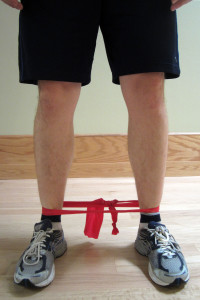Q. Hi. I have been noticing that even with my current strength training I’m pretty weak in my hip area. I’d like to work on strengthening this area, so I don’t have problems when I’m older. Can you recommend a few exercises that I can add to my routine? Thanks, I love your posts and utilize the information as often as I can. -Amy
A. Thanks, Amy, for this fantastic question! It’s wonderful that you are aware of this particular weakness and you’re being proactive now versus experiencing potential issues later. Maintaining adequate hip and pelvic strength is important for many reasons. The hip muscles control or influence most of the lower leg mechanics, including the hip, knee, and foot. They also play a role in lumbar stability and mobility. Both hip strength and mobility is vital to insure proper lower extremity movement.
Weakness and/or poor mobility in the hips can lead to potential problems including:
- Hip pain
- Knee pain
- Lumbar pain
- Abnormal gait patterns
- Increased fall risk
- Early development of osteoarthritis in the hips and knees
- Iliotibial band syndrome
- Hip bursitis
- Shin splints
- Plantar fasciitis
Many other conditions and pain can also be attributed to poor hip strength and mobility. This is by no means an all-inclusive list. I have written specific blog posts regarding many of these conditions. In each case, one of my recommended tips is to improve both hip strength and mobility. Many of the hip muscles are located deep in the pelvis and buttock area. They are not necessary large, but they are critical. These hip muscles can also be responsible for pain, particularly when spasming. Piriformis Syndrome occurs when the piriformis muscle (a deep hip rotator muscle) spasms. The spasm can cause buttock pain. Due to its proximity to the sciatic nerve, it can also cause radiating pain down into the leg known as sciatica.
How to Increase Hip Strength and Improve Mobility:
- Squat. The squat activates nearly all of the muscles in the lower leg. It is particularly effective at activating the muscles in the legs referred to as the posterior chain, which includes the hamstrings, the glutes (or buttock muscles), and the hip adductors (or the groin muscles). It also activates muscles in the hips, the calves, the stabilizing muscles in the ankles, the quadriceps, as well as the core (the abdominals and lumbar extensor muscles). These muscles are critical for all functional mobility related movements, including walking; getting up from a chair or a toilet; or picking up someone or something. For more information on squatting, please refer to 7 Reasons Why the Squat is Fundamental to Life.
- Target the hip muscles. Many of the muscles of the hip require specific exercises to insure that the correct muscle is activated. Please refer to Hip Strengthening Exercises for detailed descriptions and photos of my recommended exercises.
- Improve your mobility. Tightness and restrictions in the hip and pelvic musculature are often associated with pain in the legs and low back. Please refer to Hip Stretches and Mobilizations for detailed descriptions and photos of specific stretches for the hip and pelvis and how to self-mobilize by using a foam roller and lacrosse ball. Tightness and restrictions increase your risk of injury due to improper mobility. For example, tightness in the hip internal rotator muscles causes the hip and lower leg to roll in, which is associated with Patellar Femoral Pain Syndrome (also known as runner’s knee). For more information on this condition, please refer to How to Self-Treat Patellar Femoral Pain Syndrome.
- Self-mobilize. Using a foam roller is an excellent method to decrease pain and improve mobility throughout the hip and pelvis. For more information on how to use a foam roller, please refer to Foam Rolling for Rehabilitation.
- Walk more frequently. Walking is a critical component to healthy aging. Walking on various surfaces and terrain is an excellent way to improve your health, fitness, and hip strength. To discover other benefits walking, please refer to Why You Should Walk, Not Run.
Maintaining adequate hip and pelvis mobility and strength is an important strategy in avoiding many lower extremity orthopaedic conditions. Being aware of a particular area of weakness and being proactive now could save you from experiencing pain in the future. Thanks, Amy, for your question!
Which strategy will you use to increase your hip strength and improve mobility? It could be as simple as using the foam roller or walking. Most importantly, just get started! Please leave your comments below.
Looking for that exercise or book I mentioned in a post? Forgot the name of a product or supplement that you’re interested in? It’s all listed in the Resource Guide. Check it out today!
If you have a question that you would like featured in an upcoming blog post, please comment below or submit your question to contact@thePhysicalTherapyAdvisor.com. Be sure to join our growing community on Facebook by liking The Physical Therapy Advisor!

